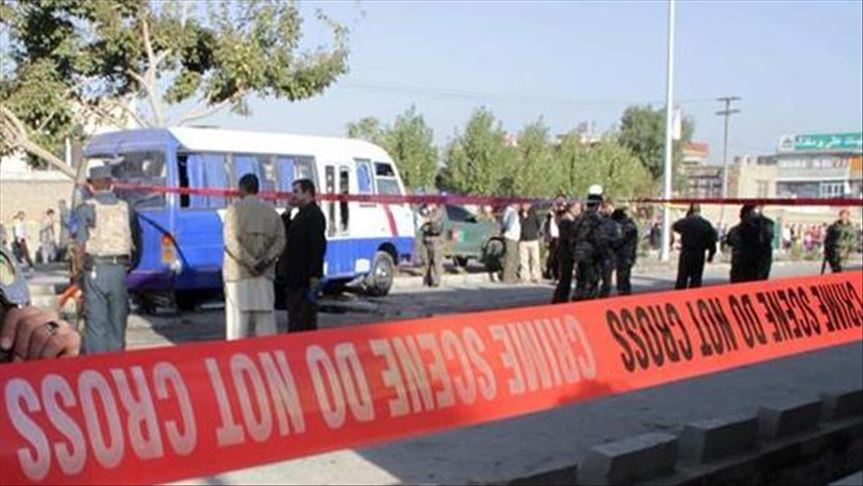2019 begins, ends with bloodshed in Afghanistan
Figures Anadolu Agency compiles suggest more than 3,000 civilians, thousands of security forces fell prey to war in 2019

KABUL, Afghanistan
With deadly precision, Taliban insurgents orchestrated lethal assaults on Afghan forces on New Year Eve similar to those exactly one year before, killing more than 30 soldiers, setting the tone for the year to come.
Afghan officials told Anadolu Agency at least 34 security forces were killed in attacks across Balkh, Takhar, Faryab and Kunduz provinces in the north New Year Eve. Police spokesman in Takhar, Khalil Aseer, said at least 11 insurgents were killed in the gunfight.
Exactly one year ago, on the eve of 2019, the Taliban stormed the administrative headquarters of Sayaad district in Sar-e-Pul province and killed at least 20 security forces in a year that saw efforts to revive the thorny peace process go hand-in-hand with the tenacious insurgency and robust counter-insurgency operations reach its 19th year.
Figures compiled by Anadolu Agency suggest the Afghan war theater saw in 2019 more than 3,000 civilians lose their lives to the various assaults claimed by Taliban militants and the Daesh/ISIS terror organization as well as the pro-government forces, mainly in aerial and search operations.
Declassified figures suggest 20 U.S. soldiers were killed while an estimated 7,000 Afghan forces and even higher number of Taliban insurgents were killed.
No safe place for civilians
In 2019, two of deadly attacks in terms of civilian death toll portray the utter grimness of the conflict.
On Aug. 17, a suicide bombing killed at least 80 men, women and children who gathered for a wedding ceremony at a hotel in downtown Kabul.
The widely condemned suicide bombing at the Dubai City wedding hall on Darul Aman road caused havoc.
Though, the Daesh/ISIS terror group claimed responsibility for the attack, Afghan President Mohammad Ashraf Ghani said the Taliban cannot escape responsibility for the “barbaric attack” since it provided a platform to terrorists in the country. “[The] Taliban cannot absolve themselves of blame, for they provide platform for terrorists,” he said in a statement a day after the attack.
Amid raging conflict across the country, traditional wedding parties have been an escape for the war-weary Afghans giving them rare moments of happiness.
The second attack came at a sacred mosque meant for prayers for forgiveness and blessings. On Oct. 18, a bomb rocked a mosque in Haska Maina district of eastern Nangarhar province killing more than 60 people. There was no immediate claim of responsibility for the attack, with the Taliban rejecting involvement.
An evident surge in night raids and aerial bombardment by pro-government forces in 2019 added to the woes of the civilian population caught between warring sides.
In its last quarterly report issued, the UN Assistance Mission in Afghanistan showed record-high levels of civilian casualties in the first nine months of 2019, indicating an urgent need for all parties to do more to protect civilians.
For the 8,239 civilian casualties (2,563 killed and 5,676 injured), the UN blamed anti-government elements for 5,117 civilian casualties (1,207 killed and 3,910 injured), accounting for 62% of all civilian casualties and the pro-government forces for causing 2,348 civilian casualties (1,149 killed and 1,199 injured).
Escalating casualties among Afghan combatants, insurgents
As per the U.S. Special Inspector General for Afghanistan Reconstruction’s (SIGAR) quarterly report, casualties among Afghan security forces increased 5% from June through August compared with the same period last in 2018. This comes as the U.S. Department of Defense already dubbed casualties among Afghan security forces as “unsustainable.”
According to the SIGAR, officials continue to classify most casualty data but a general UN-classified data suggest a 5% rise in casualties among Afghan forces. The latest official toll came from Ghani when he revealed in late 2018 that more than 28,000 Afghan forces have been killed since 2015, which amounts to an alarming annual average of 7,000 deaths.
Casualties among Taliban insurgents have been higher. U.S. Secretary of State Michael Pompeo said the U.S. and Afghan forces killed at least 1,000 insurgents from Aug. 28 to Sept. 8, while Ghani said 2,000 insurgents have been killed in counter-terror operations Sept. 6-13.








